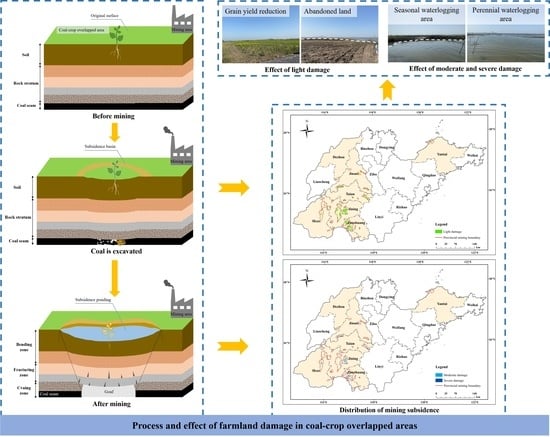Assessment and Effect of Mining Subsidence on Farmland in Coal–Crop Overlapped Areas: A Case of Shandong Province, China
Abstract
:1. Introduction
2. Materials and Methods
2.1. Overview of the Study Area
2.1.1. Natural Condition
2.1.2. Distribution Characteristics of Coal–Crop Overlapped Areas
2.2. Methods
2.2.1. Current Situation of Damaged Farmland
2.2.2. Mining Subsidence Prediction
2.2.3. Damaged Farmland Forecast
2.2.4. Construction of a Model for Farmland Yield Caused Coal Mining Subsidence
3. Results
3.1. Current Distribution of Damaged Farmland
3.2. Spatiotemporal Distribution of Coal Mining Subsidence Prediction
3.3. Spatiotemporal Distribution of Farmland Damage Prediction
3.4. Impact and Assessment of Farmland Damage
3.4.1. Reduced Grain Production
3.4.2. Change of Farmland Landscape Pattern
3.4.3. Damage to Ecological Environment
4. Discussion
4.1. Impact of Farmland Damage on Social Stability
4.2. Limitations and Outlooks
5. Conclusions
Author Contributions
Funding
Institutional Review Board Statement
Informed Consent Statement
Data Availability Statement
Acknowledgments
Conflicts of Interest
References
- Xu, J.; Ma, N.; Xie, H. Ecological Coal Mining Based Dynamic Equilibrium Strategy to Reduce Pollution Emissions and Energy Consumption. J. Clean. Prod. 2017, 167, 514–529. [Google Scholar] [CrossRef]
- Dai, S.; Ren, D.; Chou, C.L.; Finkelman, R.B.; Seredin, V.V.; Zhou, Y. Geochemistry of Trace Elements in Chinese Coals: A Review of Abundances, Genetic Types, Impacts on Human Health, and Industrial Utilization. Int. J. Coal Geol. 2012, 94, 3–21. [Google Scholar] [CrossRef]
- Li, Y.; Chiu, Y.H.; Lin, T.Y. Coal Production Efficiency and Land Destruction in China’s Coal Mining Industry. Resour. Policy 2019, 63, 101449. [Google Scholar] [CrossRef]
- Bian, Z.; Lei, S.; Jin, D.; Wang, L. Several Basic Scientific Issues Related to Mined Land Remediation. Meitan Xuebao J. China Coal Soc. 2018, 43, 190–197. [Google Scholar]
- Hu, Z.; Fu, Y.; Xiao, W.; Zhao, Y.; Wei, T. Ecological Restoration Plan for Abandoned Underground Coal Mine Site in Eastern China. Int. J. Min. Reclam. Environ. 2015, 29, 316–330. [Google Scholar] [CrossRef]
- He, T.; Xiao, W.; Zhao, Y.L.; Deng, X.; Hu, Z. Identification of Waterlogging in Eastern China Induced by Mining Subsidence: A Case Study of Google Earth Engine Time-Series Analysis Applied to the Huainan Coal Field. Remote Sens. Environ. 2020, 242, 111742. [Google Scholar] [CrossRef]
- Liu, S.; Li, W.; Qiao, W.; Wang, Q.; Hu, Y.; Wang, Z. Effect of Natural Conditions and Mining Activities on Vegetation Variations in Arid and Semiarid Mining Regions. Ecol. Indic. 2019, 103, 331–345. [Google Scholar] [CrossRef]
- Hu, Z.; Liu, S.; Gong, Y. Evaluation of Soil Quality and Maize Growth in Different Profiles of Reclaimed Land with Coal Gangue Filling. Land 2021, 10, 1307. [Google Scholar] [CrossRef]
- Xiao, W.; Hu, Z.; Fu, Y. Zoning of Land Reclamation in Coal Mining Area and New Progresses for the Past 10 Years. Int. J. Coal Sci. Technol. 2014, 1, 177–183. [Google Scholar] [CrossRef]
- Ren, H.; Zhao, Y.; Xiao, W.; Hu, Z. A Review of UAV Monitoring in Mining Areas: Current Status and Future Perspectives. Int. J. Coal Sci. Technol. 2019, 6, 320–333. [Google Scholar] [CrossRef]
- Xu, J.; Li, G.; Chen, G.; Zhao, H. Dynamic Changes and Evaluation of Land Ecological Quality in Coal Mining Area. J. China Coal Soc. 2013, 38, 180–185. [Google Scholar]
- He, X.; Song, L. Status and Future Tasks of Coal Mining Safety in China. Saf. Sci. 2012, 50, 894–898. [Google Scholar] [CrossRef]
- Feng, Y.; Wang, J.; Bai, Z.; Reading, L. Effects of Surface Coal Mining and Land Reclamation on Soil Properties: A Review. Earth Sci. Rev. 2019, 191, 12–25. [Google Scholar] [CrossRef]
- Bian, Z.; Miao, X.; Lei, S.; Chen, S.E.; Wang, W.; Struthers, S. The Challenges of Reusing Mining and Mineral-Processing Wastes. Science 2012, 337, 702–703. [Google Scholar] [CrossRef]
- Hu, Z.; Duo, L.; Wang, X. Principle and Method of Reclaiming Subsidence Land with Inter-Layers of Filling Materals. Meitan Xuebao/J. China Coal Soc. 2018, 43, 198–206. [Google Scholar]
- Lu, C.; Lu, C.; Li, H.; Liu, B.; Sun, Q.; Li, C. Groundwater Influencing Mechanism in Water-Ponding Process of Huainan Coal Mining Subsidence Area. Trans. Chin. Soc. Agric. Eng. 2015, 10, 122–131. [Google Scholar]
- He, T.; Xiao, W.; Zhao, Y.; Chen, W.; Deng, X.; Zhang, J. Continues Monitoring of Subsidence Water in Mining Area from the Eastern Plain in China from 1986 to 2018 Using Landsat Imagery and Google Earth Engine. J. Clean. Prod. 2021, 279, 123610. [Google Scholar] [CrossRef]
- Hu, Z.; Shao, F.; McSweeney, K. Reclaiming Subsided Land with Yellow River Sediments: Evaluation of Soil-Sediment Columns. Geoderma 2017, 307, 210–219. [Google Scholar] [CrossRef]
- Xiao, W.; Fu, Y.; Wang, T.; Lv, X. Effects of Land Use Transitions Due to Underground Coal Mining on Ecosystem Services in High Groundwater Table Areas: A Case Study in the Yanzhou Coalfield. Land Use Policy 2018, 71, 213–221. [Google Scholar] [CrossRef]
- Hu, Z.; Li, J.; Zhao, Y. Problems, Reasons and Countermeasures for Environmental Quality and Food Safety in the Overlapped Areas of Crop and Mineral Production. Sci. Technol. Rev. 2006, 3, 21–24. [Google Scholar]
- Hu, Z.; Luo, Y. Suggestion on Environmental Quality and Food Safety in Overlapped Areas of Crop and Mineral Production. Sci. Technol. Rev. 2006, 3, 93–94. [Google Scholar]
- Chugh, Y.P. Concurrent Mining and Reclamation for Underground Coal Mining Subsidence Impacts in China. Int. J. Coal Sci. Technol. 2018, 5, 18–35. [Google Scholar] [CrossRef]
- Yang, G.; Yang, Y.; Gao, Y.; Yu, Y.; Lin, S.; Li, Y. Farmland Damage and Treatment Status in Coal Mining Subsidence Area with High Phreatic Water Level. Adv. Mater. Res. 2014, 838–841, 2190–2194. [Google Scholar] [CrossRef]
- Wang, J.; Chen, Y.; Shao, X.; Zhang, Y.; Cao, Y. Land-Use Changes and Policy Dimension Driving Forces in China: Present, Trend and Future. Land Use Policy 2012, 29, 737–749. [Google Scholar] [CrossRef]
- Deng, X.; Zeng, M.; Xu, D.; Wei, F. Household Health and Cropland Abandonment in Rural China: Theoretical Mechanism and Empirical Evidence. Int. J. Environ. Res. Public Health 2019, 16, 3588. [Google Scholar] [CrossRef]
- Asr, E.T.; Kakaie, R.; Ataei, M.; Tavakoli Mohammadi, M.R. A Review of Studies on Sustainable Development in Mining Life Cycle. J. Clean. Prod. 2019, 229, 213–231. [Google Scholar] [CrossRef]
- Li, Q.; Stoeckl, N.; King, D.; Gyuris, E. Exploring the Impacts of Coal Mining on Host Communities in Shanxi, China—Using Subjective Data. Resour. Policy 2017, 53, 125–134. [Google Scholar] [CrossRef]
- Li, L.; Lei, Y.; Wu, S.; He, C.; Yan, D. Study on the Coordinated Development of Economy, Environment and Resource in Coal-Based Areas in Shanxi Province in China: Based on the Multi-Objective Optimization Model. Resour. Policy 2018, 55, 80–86. [Google Scholar] [CrossRef]
- Zhang, M.; Wang, J.; Feng, Y. Temporal and Spatial Change of Land Use in a Large-Scale Opencast Coal Mine Area: A Complex Network Approach. Land Use Policy 2019, 86, 375–386. [Google Scholar] [CrossRef]
- Hu, Z.; Yang, G.; Xiao, W.; Li, J.; Yang, Y.; Yu, Y. Farmland Damage and Its Impact on the Overlapped Areas of Cropland and Coal Resources in the Eastern Plains of China. Resour. Conserv. Recycl. 2014, 86, 1–8. [Google Scholar] [CrossRef]
- Li, J.; Hu, Z.; Li, L. Farmland Damage and Its Impacts in Overlapped Areas of Cropland and Coal Resources in One Typical City of China. J. Liaoning Tech. Univ. 2008, 27, 148–151. [Google Scholar]
- Song, Y.; Hu, Z.; Chen, S.; Li, L. Plantation-Evolution Forecasting System in the Overlapping Area of Crop and Coal Production. Coal Eng. 2008, 02, 123–125. [Google Scholar]
- Zhao, X.; Li, J.; Liu, Z.; Li, W.; Zhang, P.; Zhou, S. Evaluation of Damaged Farmland Extent in Overlapped Areas of Farmland and Coal Resources with High Phreatic Water Level. Environ. Sci. Technol. 2014, 37, 177–181+192. [Google Scholar]
- Shi, X.; Hu, Z.; Hou, Z.; Li, Y. Plantation-Evolution Forecast of the Overlapped Area of Crop and Coal Production on a Small Scale. Met. Mine 2013, 42, 134–137. [Google Scholar]
- Chen, J.P.; Hu, Z.Q.; Yuan, D.Z.; Zhang, R.Y.; Xu, T. Prediction and Influence of Cultivated Land Evolution in the Overlapped Area of Crop and Coal Production in Fengtai County. J. Min. Sci. Technol. 2018, 3, 13–21. [Google Scholar]
- Yan, H.; Ding, Z.; Li, G. Conservation of Prime Farmland in Overlapped Areas of Cropland and Coal Resources. Hubei Agric. Sci. 2011, 50, 1984–1987. [Google Scholar]
- Gao, T.; Zhao, H. Contradiction between Coal Mining and Basic Farm Protection and Coordination. Sci. Technol. Manag. L. Resour. 2011, 2, 115–118. [Google Scholar]
- Yang, Z.; Hou, H.; Ding, Z.; Wang, H. Reclassification and Ecological Effect Analysis of Farmland Ecosystem in Overlapped Areas of Farmland and Coal Resources. Jiangsu Agric. Sci. 2018, 22, 280–286. [Google Scholar]
- Li, L.; Zhao, Y.; Yang, L. Study on Changes of Ecosystem Service Value of Overlapped Area of Coal and Crop—A Case Study of Zoucheng City. Resour. Dev. Mark. 2008, 3, 205–207. [Google Scholar]
- Wang, L.; Zhang, H.; Hu, W.; Yu, Z. Functional Evaluation of Land Use Based on Production-Living-Ecology View in Areas of Cropland and Coal Resources. Bull. Soil Water Conserv. 2018, 38, 301–306. [Google Scholar]
- Ma, S.; Xie, F.; Ding, C.; Zhang, H. Spatio-Temporal Change of Landscape Ecological Quality and Influencing Factors Based on Four-Quadrant Model in Overlapped Area of Cropland and Coal Production. Trans. Chin. Soc. Agric. Eng. 2020, 36, 259–268+323. [Google Scholar]
- Zhang, B.; Zhang, L.; Yang, H.; Zhang, Z.; Tao, J. Subsidence Prediction and Susceptibility Zonation for Collapse above Goaf with Thick Alluvial Cover: A Case Study of the Yongcheng Coalfield, Henan Province, China. Bull. Eng. Geol. Environ. 2016, 75, 1117–1132. [Google Scholar] [CrossRef]
- He, G. Mining Subsidence Science; China University of Mining and Technology Press: Beijing, China, 1991. [Google Scholar]
- Jiao, H. Research on the Development Model of Coal City in China; Peking University: Beijing, China, 1998. [Google Scholar]
- Zhao, Y.; Xu, X.; He, T.; Li, Y.; Hu, J. Changes of Land Use and Environment in Underground Coal Mining Area in China. Disaster Adv. 2013, 6, 125–131. [Google Scholar]
- Zhang, B.; Luo, H.; Lv, L.; Wang, J.; Zhang, B. Analysis of Ecological Environment Impact of Coal Exploitation and Utilization. IOP Conf. Ser. Earth Environ. Sci. 2018, 121, 032002. [Google Scholar] [CrossRef]
- Wu, X.; Pan, W. Investigation of Effect of Coal Resources Exploitation on Ecological Environment in China. China Sci. 2014, 9, 600–604. [Google Scholar]
- Antwi, E.K.; Krawczynski, R.; Wiegleb, G. Detecting the Effect of Disturbance on Habitat Diversity and Land Cover Change in a Post-Mining Area Using GIS. Landsc. Urban Plan. 2008, 87, 22–32. [Google Scholar] [CrossRef]
- Luan, J.; Zhang, Y.; Tian, J.; Meresa, H.; Liu, D. Coal Mining Impacts on Catchment Runoff. J. Hydrol. 2020, 589, 125101. [Google Scholar] [CrossRef]
- Yan, M.; Fan, L.; Wang, L. Restoration of Soil Carbon with Different Tree Species in a Post-Mining Land in Eastern Loess Plateau, China. Ecol. Eng. 2020, 158, 106025. [Google Scholar] [CrossRef]
- Ge, D.; Long, H.; Zhang, Y.; Li, M.; Li, T. Farmland Transition and Its Influences on Grain Production in China. Land Use Policy 2018, 70, 94–105. [Google Scholar] [CrossRef]
- Diao, X.; Wu, K.; Zhou, D.; Li, L. Integrating the Probability Integral Method for Subsidence Prediction and Differential Synthetic Aperture Radar Interferometry for Monitoring Mining Subsidence in Fengfeng, China. J. Appl. Remote Sens. 2016, 10, 016028. [Google Scholar] [CrossRef]
- Wang, J.; Wang, P.; Qin, Q.; Wang, H. The Effects of Land Subsidence and Rehabilitation on Soil Hydraulic Properties in a Mining Area in the Loess Plateau of China. Catena 2017, 159, 51–59. [Google Scholar] [CrossRef]
- Gao, C.; Xu, N.; Liu, G.; Tian, G. Effect of Roadway Layout in Protective Coal Pillar on Subsidence of Buildings Such as Villages. Coal Eng. 2019, 51, 116–120. [Google Scholar]
- Chen, J.; Hu, Z.; Yuan, D.; Zhao, H. Change of Farming Radius of Relocated Villages and Its Influence in Coal Mining Subsidence Areas. Trans. Chin. Soc. Agric. Eng. 2019, 35, 287–295. [Google Scholar]
- Qian, M.; Xu, J.; Miao, X. Green Technique in Coal Ming. J. China Univ. Min. Technol. 2003, 04, 5–10. [Google Scholar]
- Guo, W.; Zhao, G.; Bai, E.; Ma, C.; Nie, X.; Chen, J.; Zhang, H. Research Status and Prospect on Cultivated Land Damage at Surface Subsidence Basin Due to Longwall Mining in the Central Coal Grain Compound Area. J. China Coal Soc. 2022, 1–12. [Google Scholar] [CrossRef]
- Wu, X.; Zhenqi, H.; Riuya, Z.; Yanling, Z. A Simulation of Mining Subsidence and Its Impacts to Land in High Ground Water Area—An Integrated Approach Based on Subsidence Prediction and GIS. Disaster Adv. 2013, 6, 142–148. [Google Scholar]
- Fu, M.; Hu, Z.; Liu, S. Farmland Restoration and Pollution Prevention in the Overlapped Areas of Crop and Mineral Production. Met. Mine 2008, 9, 119–122. [Google Scholar]
- Wu, Q.; Pang, J.; Qi, S.; Li, Y.; Han, C.; Liu, T.; Huang, L. Impacts of Coal Mining Subsidence on the Surface Landscape in Longkou City, Shandong Province of China. Environ. Earth Sci. 2009, 59, 783–791. [Google Scholar]
- Xiao, W.; Zheng, W.; Zhao, Y.; Chen, J.; Hu, Z. Examining the Relationship between Coal Mining Subsidence and Crop Failure in Plains with a High Underground Water Table. J. Soils Sediments 2021, 21, 2908–2921. [Google Scholar] [CrossRef]
- Xiao, W.; Hu, Z.; Chugh, Y.P.; Zhao, Y. Dynamic Subsidence Simulation and Topsoil Removal Strategy in High Groundwater Table and Underground Coal Mining Area: A Case Study in Shandong Province. Int. J. Min. Reclam. Environ. 2014, 28, 250–263. [Google Scholar] [CrossRef]
- Huang, X.; Yang, G.; Yang, Y.; Li, W.; Chen, H.; Wang, H. Problems and Suggestions of Coal Mining Subsided Land Governance in Jining City of Shandong Province. Adv. Mater. Res. 2014, 838–841, 1826–1829. [Google Scholar] [CrossRef]
- Xu, D.; Deng, X.; Guo, S.; Liu, S. Labor Migration and Farmland Abandonment in Rural China. J. Environ. Manag. 2018, 232, 738–750. [Google Scholar] [CrossRef] [PubMed]
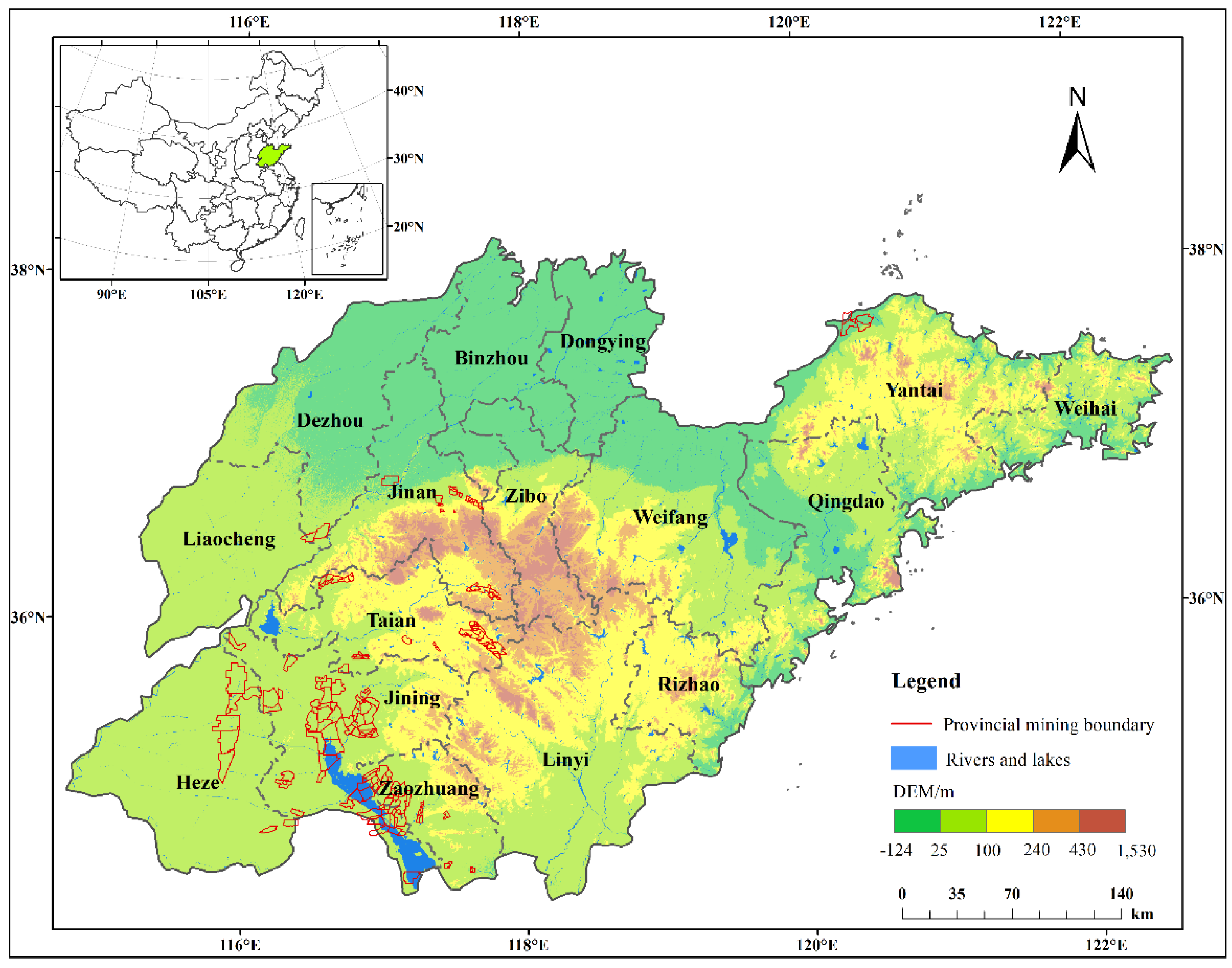

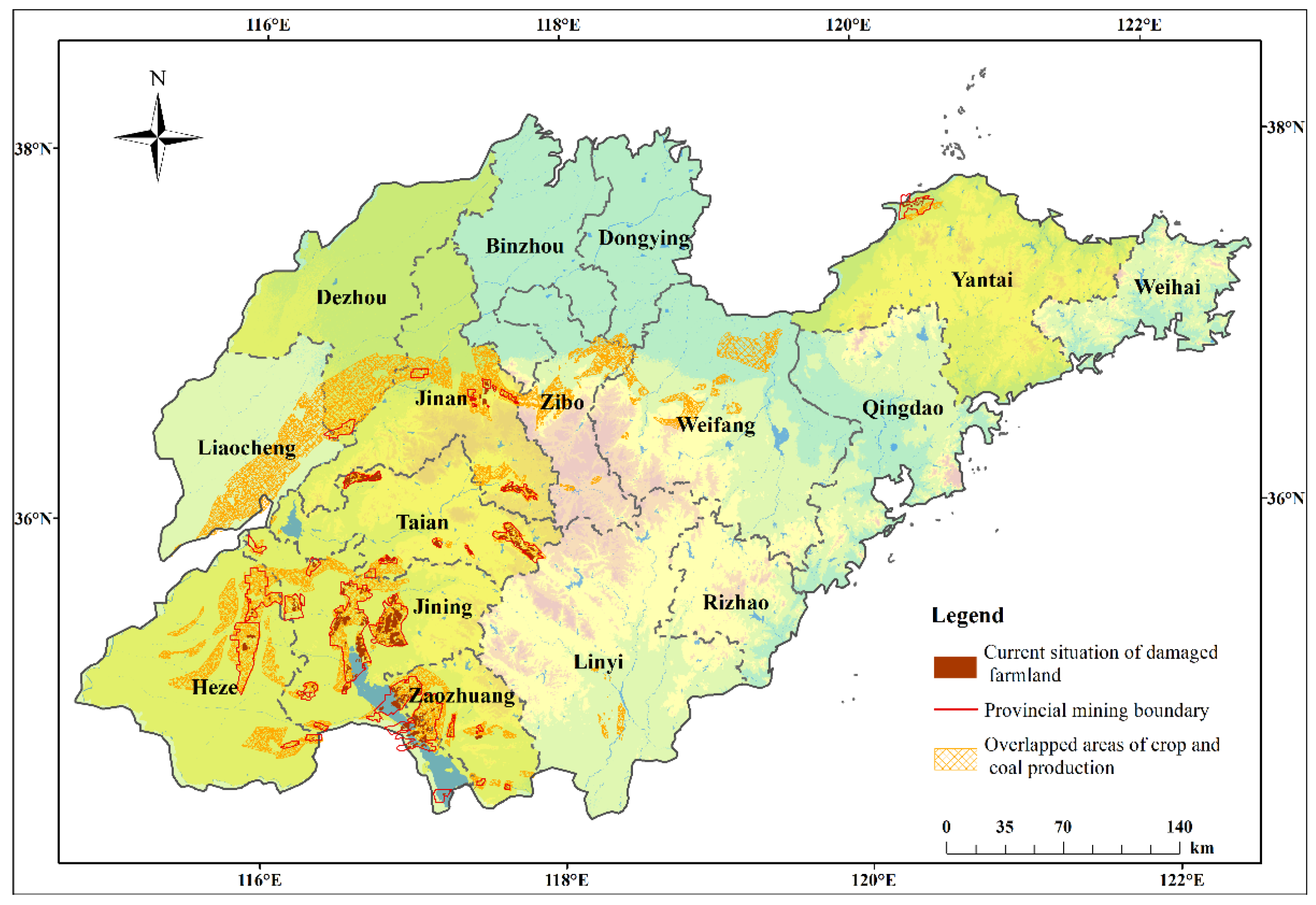

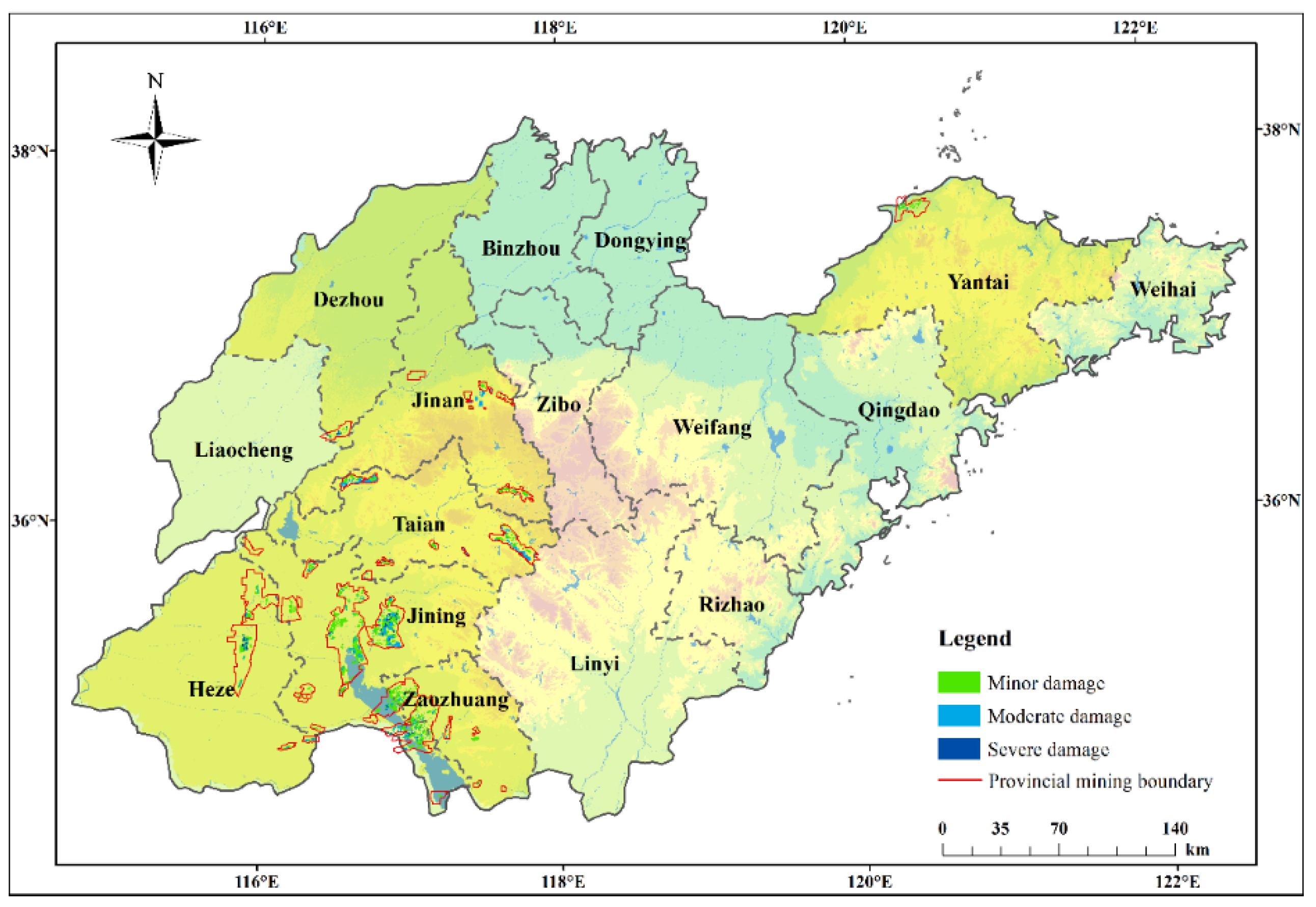

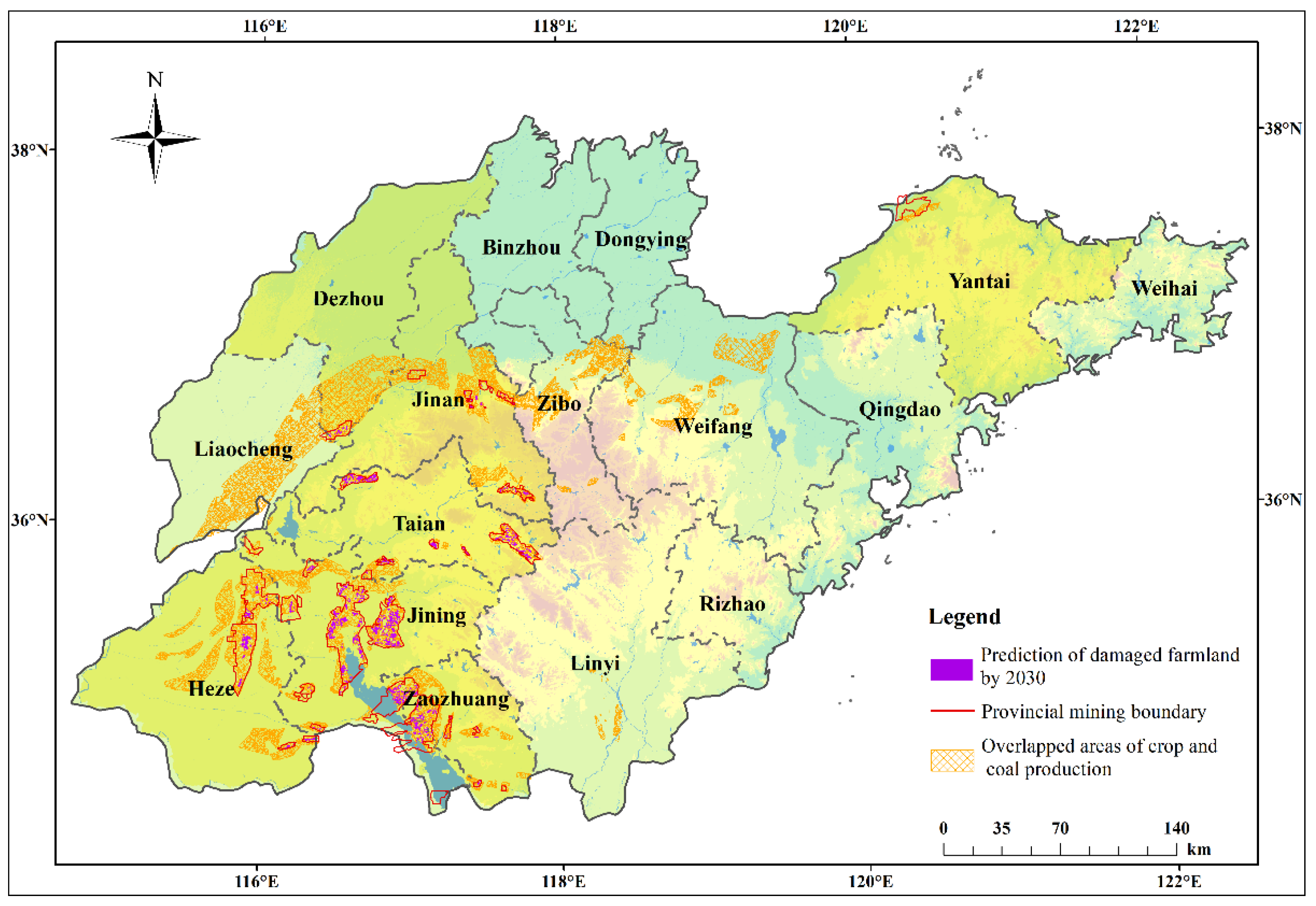
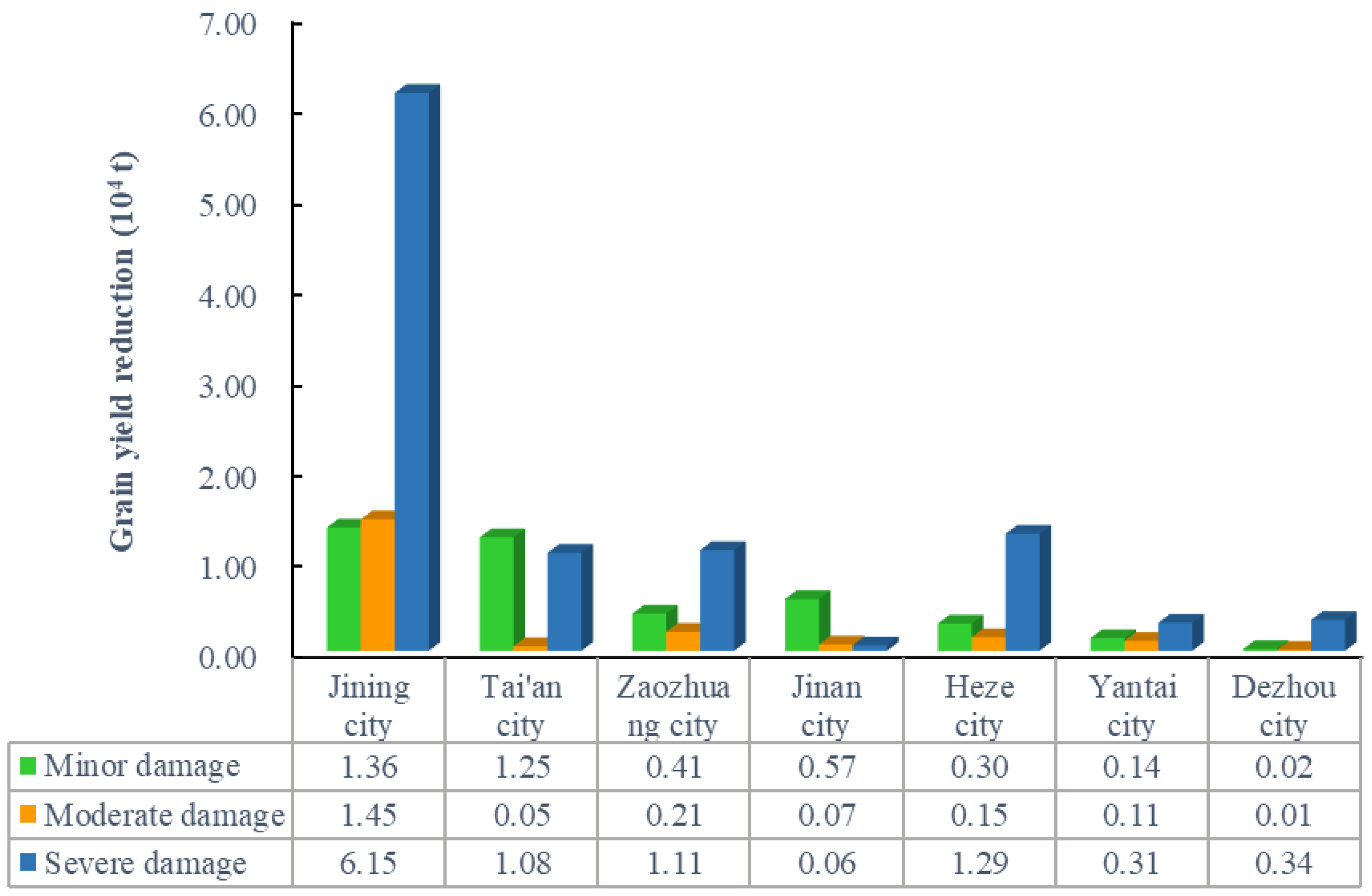
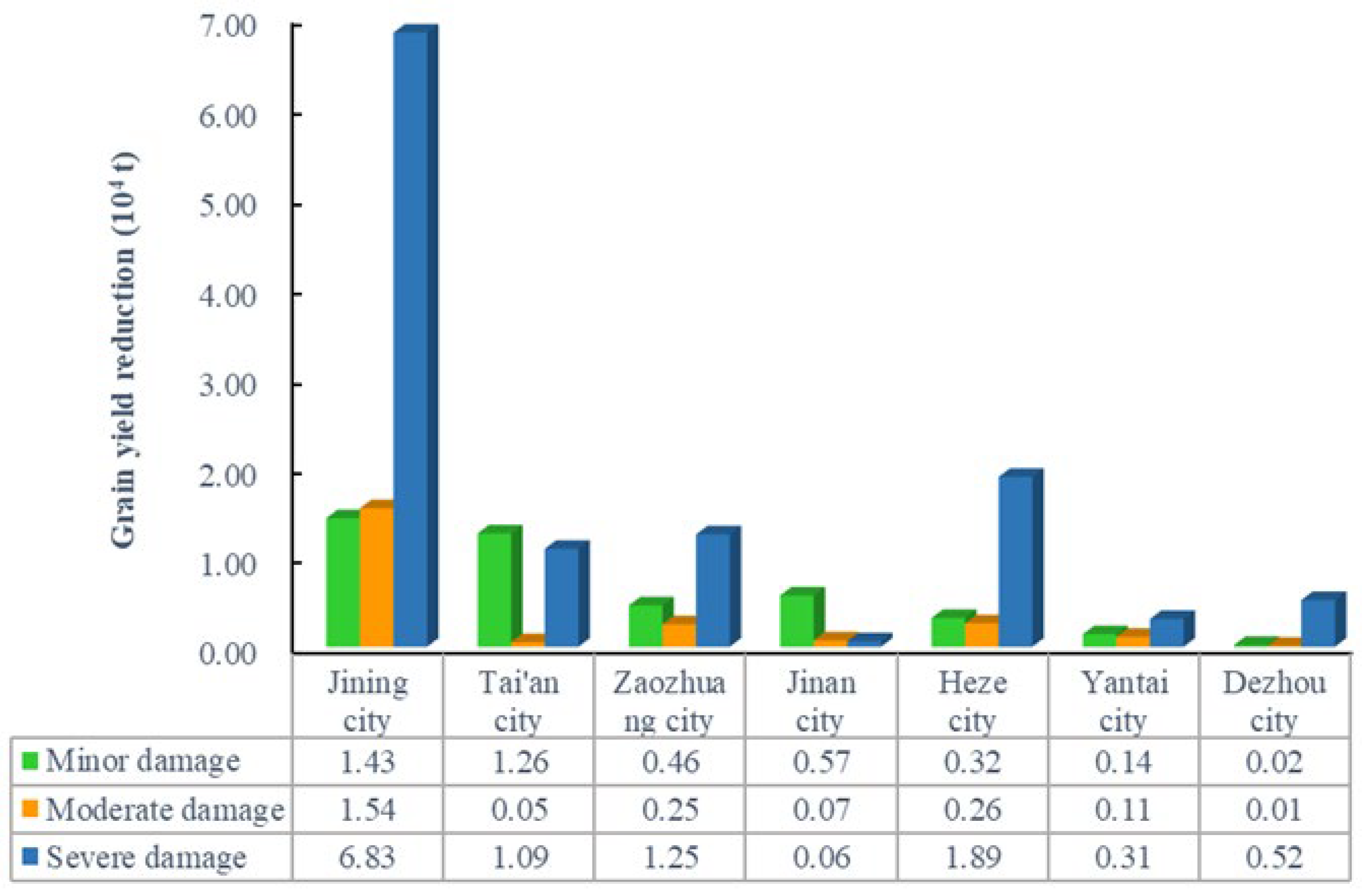
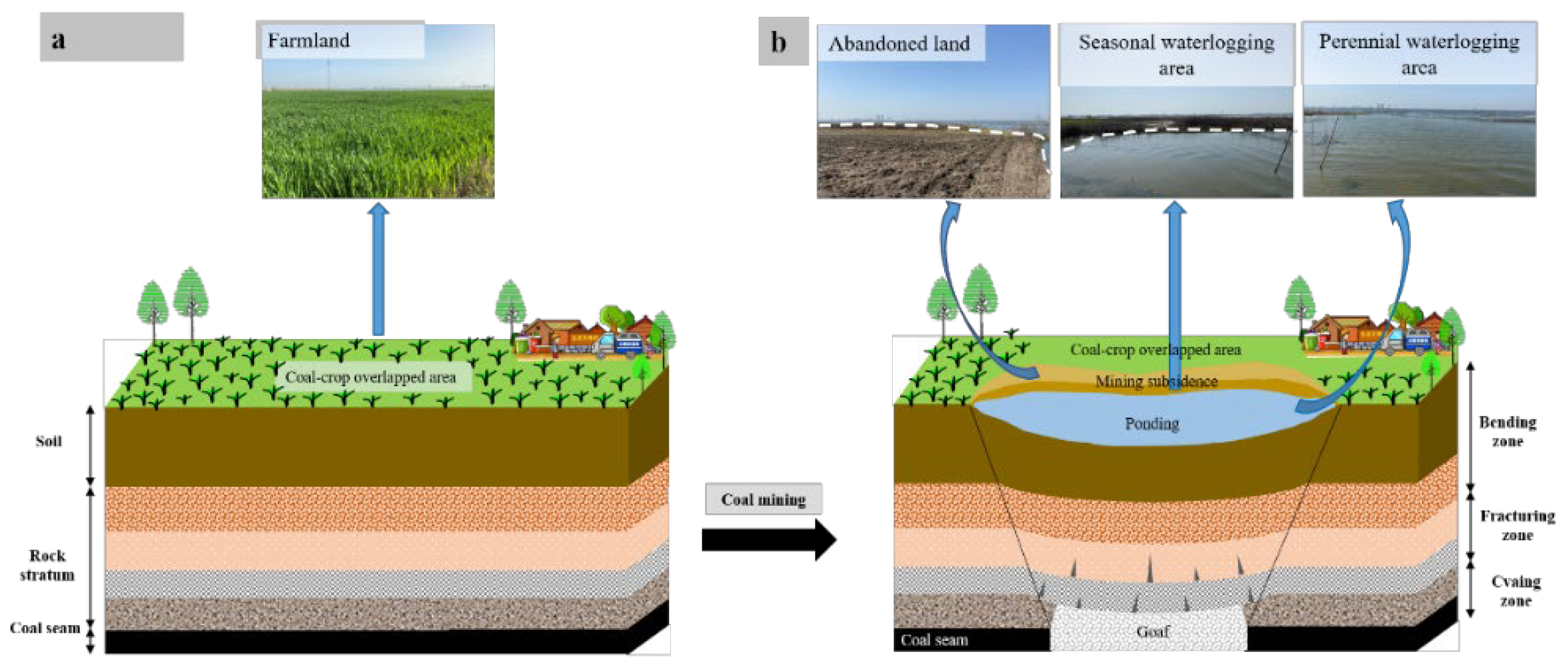

| City Name | Minor Damage | Moderate Damage | Severe Damage |
|---|---|---|---|
| Jinan city | 0.1–0.6 | 0.6–1.5 | >1.5 |
| Zaozhuang city | 0.3–1.0 | 1.0–3.0 | >3.0 |
| Yantai city | 0.3–0.5 | 1.5–3.0 | >3.0 |
| Jining city | 0.3–1.0 | 1.0–3.0 | >3.0 |
| 0.3–1.5 | 1.5–3.5 | >3.5 | |
| 0.1–0.8 | 0.8–3.5 | >3.5 | |
| Tai’an city | 0.3–1.5 | 1.5–3.0 | >3.0 |
| 0.5–1.5 | >1.5 | - | |
| Dezhou city | 0.3–0.6 | 0.6–0.8 | >0.8 |
| Heze city | 0.3–1.5 | 1.5–3.0 | >3.0 |
| 0.2–1.0 | 1.0–2.5 | >2.5 |
| City Name | Total Damage Area (ha) | Proportion of the Total Damaged Area (%) | Area of Reduced-Yield Farmland (ha) | Area of Non-Yield Farmland (ha) |
|---|---|---|---|---|
| Jining city | 29,020.68 | 45.37 | 20,647.50 | 8373.18 |
| Tai’an city | 15,293.37 | 23.91 | 13,571.87 | 1721.50 |
| Zaozhuang city | 6078.15 | 9.50 | 4556.00 | 1522.15 |
| Jinan city | 6509.64 | 10.18 | 6408.07 | 101.57 |
| Heze city | 3915.64 | 6.12 | 2550.74 | 1364.90 |
| Yantai city | 2529.85 | 3.96 | 2051.37 | 478.48 |
| Dezhou city | 613.65 | 0.96 | 215.00 | 398.65 |
| Total | 63,960.98 | 100.00 | 50,000.55 | 13,960.43 |
| Year | Minor Damage | Moderate Damage | Severe Damage | Total Damaged Area (ha) | Proportion of Provincial Area (%) | |||
|---|---|---|---|---|---|---|---|---|
| Area (ha) | Proportion of Total Damaged Area (%) | Area (ha) | Proportion of Total Damaged Area (%) | Area (ha) | Proportion of Total Damaged Area (%) | |||
| 2025 | 68,723.52 | 66.93 | 25,723.58 | 25.05 | 8231.41 | 8.02 | 102,678.51 | 0.65 |
| 2030 | 72,825.86 | 59.41 | 36,050.20 | 29.41 | 13,702.79 | 11.18 | 122,578.85 | 0.78 |
| The Degree of Damage | By2025 | By2030 | ||||
|---|---|---|---|---|---|---|
| Damaged Area (ha) | Proportion of Total Damaged Area (%) | Proportion of the Overlapped Area (%) | Damaged Area (ha) | Proportion of Total Damaged Area (%) | Proportion of the Overlapped Area (%) | |
| Light damage | 42,612.60 | 61.10 | 4.19 | 44,167.48 | 58.76 | 4.34 |
| Moderate damage | 10,782.60 | 15.46 | 1.06 | 12,117.69 | 16.12 | 1.19 |
| Severe damage | 16,345.94 | 23.44 | 1.61 | 18,886.41 | 25.12 | 1.86 |
| Total | 69,741.14 | — | 6.86 | 75,171.58 | — | 7.39 |
| City Name | Total Damaged Area (ha) | Minor Damage | Moderate Damage | Severe Damage | |||
|---|---|---|---|---|---|---|---|
| Damaged Area (ha) | Proportion of Total Damaged Area (%) | Damaged Area (ha) | Proportion of Total Damaged Area (%) | Damaged Area (ha) | Proportion of Total Damaged Area (%) | ||
| Jining city | 31,663.45 | 14,318.94 | 45.22 | 7624.04 | 24.08 | 9720.47 | 30.70 |
| Tai’an city | 15,126.8 | 13,149.98 | 86.93 | 268.37 | 1.77 | 1708.45 | 11.29 |
| Zaozhuang city | 7159.76 | 4297.37 | 60.02 | 1109.37 | 15.49 | 1753.02 | 24.48 |
| Jinan city | 6509.64 | 6031.12 | 92.65 | 376.95 | 5.79 | 101.57 | 1.56 |
| Heze city | 6029.27 | 3200.12 | 53.08 | 784.83 | 13.02 | 2044.32 | 33.91 |
| Yantai city | 2500.3 | 1452.43 | 58.09 | 564.83 | 22.59 | 483.04 | 19.32 |
| Dezhou city | 751.92 | 162.64 | 21.63 | 54.21 | 7.21 | 535.07 | 71.16 |
| Total | 69,741.14 | 42,612.6 | 61.10 | 10,782.6 | 15.46 | 16,345.94 | 23.44 |
| City Name | Total Damaged Area (ha) | Minor Damage | Moderate Damage | Severe Damage | |||
|---|---|---|---|---|---|---|---|
| Damaged Area (ha) | Proportion of Total Damaged Area (%) | Damaged Area (ha) | Proportion of Total Damaged Area (%) | Damaged Area (ha) | Proportion of Total Damaged Area (%) | ||
| Jining city | 34,017.68 | 15,092.18 | 44.37 | 8126.56 | 23.89 | 10,798.94 | 31.75 |
| Tai’an city | 15,223.45 | 13,232.23 | 86.92 | 270.05 | 1.77 | 1721.17 | 11.31 |
| Zaozhuang city | 8130.45 | 4810.93 | 59.17 | 1342.76 | 16.52 | 1976.76 | 24.31 |
| Jinan city | 6509.64 | 6031.12 | 92.65 | 376.95 | 5.79 | 101.57 | 1.56 |
| Heze city | 7742.56 | 3380.07 | 43.66 | 1377.23 | 17.79 | 2985.26 | 38.56 |
| Yantai city | 2504.12 | 1455.18 | 58.11 | 565.9 | 22.60 | 483.04 | 19.29 |
| Dezhou city | 1043.68 | 165.77 | 15.88 | 58.24 | 5.58 | 819.67 | 78.54 |
| Total | 75,171.58 | 44,167.48 | 58.76 | 12,117.69 | 16.12 | 18,886.41 | 25.12 |
Publisher’s Note: MDPI stays neutral with regard to jurisdictional claims in published maps and institutional affiliations. |
© 2022 by the authors. Licensee MDPI, Basel, Switzerland. This article is an open access article distributed under the terms and conditions of the Creative Commons Attribution (CC BY) license (https://creativecommons.org/licenses/by/4.0/).
Share and Cite
Chen, Y.; Hu, Z.; Li, P.; Li, G.; Yuan, D.; Guo, J. Assessment and Effect of Mining Subsidence on Farmland in Coal–Crop Overlapped Areas: A Case of Shandong Province, China. Agriculture 2022, 12, 1235. https://doi.org/10.3390/agriculture12081235
Chen Y, Hu Z, Li P, Li G, Yuan D, Guo J. Assessment and Effect of Mining Subsidence on Farmland in Coal–Crop Overlapped Areas: A Case of Shandong Province, China. Agriculture. 2022; 12(8):1235. https://doi.org/10.3390/agriculture12081235
Chicago/Turabian StyleChen, Yang, Zhenqi Hu, Pengyu Li, Gensheng Li, Dongzhu Yuan, and Jiaxin Guo. 2022. "Assessment and Effect of Mining Subsidence on Farmland in Coal–Crop Overlapped Areas: A Case of Shandong Province, China" Agriculture 12, no. 8: 1235. https://doi.org/10.3390/agriculture12081235
APA StyleChen, Y., Hu, Z., Li, P., Li, G., Yuan, D., & Guo, J. (2022). Assessment and Effect of Mining Subsidence on Farmland in Coal–Crop Overlapped Areas: A Case of Shandong Province, China. Agriculture, 12(8), 1235. https://doi.org/10.3390/agriculture12081235





